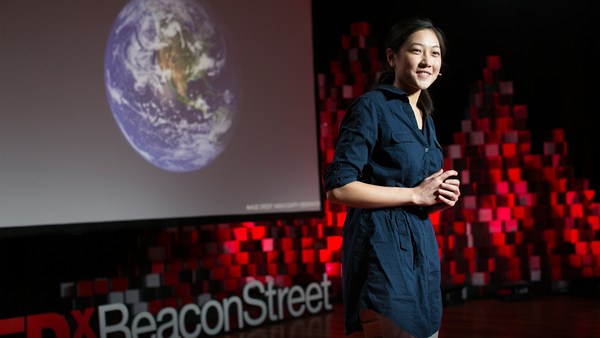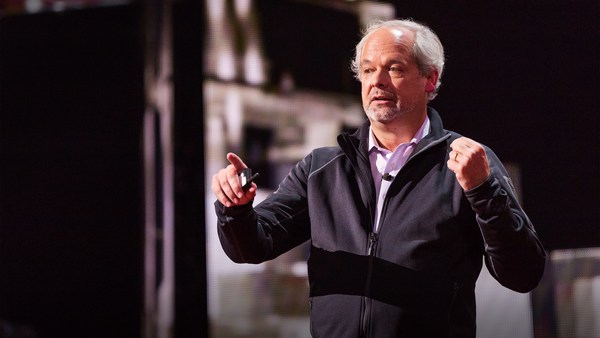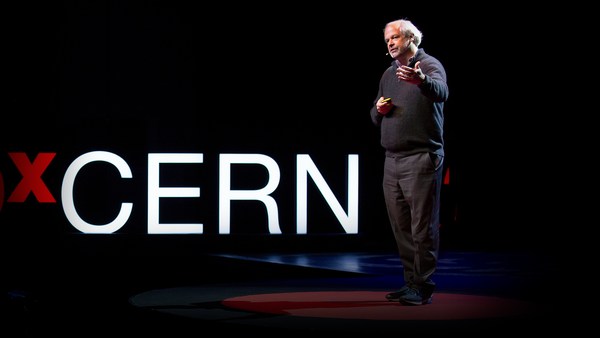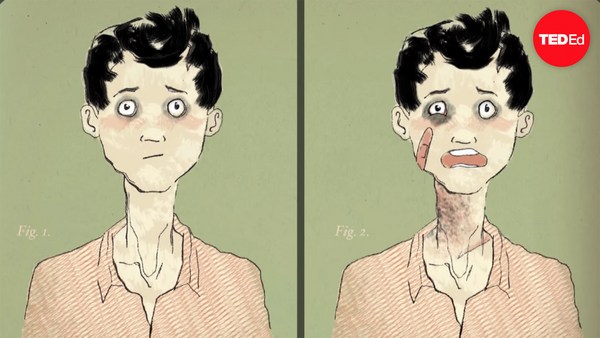Here's a question that matters.
[Is it ethical to evolve the human body?]
Because we're beginning to get all the tools together to evolve ourselves. And we can evolve bacteria and we can evolve plants and we can evolve animals, and we're now reaching a point where we really have to ask, is it really ethical and do we want to evolve human beings? And as you're thinking about that, let me talk about that in the context of prosthetics, prosthetics past, present, future.
So this is the iron hand that belonged to one of the German counts. Loved to fight, lost his arm in one of these battles. No problem, he just made a suit of armor, put it on, perfect prosthetic. That's where the concept of ruling with an iron fist comes from.
And of course these prosthetics have been getting more and more useful, more and more modern. You can hold soft-boiled eggs. You can have all types of controls, and as you're thinking about that, there are wonderful people like Hugh Herr who have been building absolutely extraordinary prosthetics. So the wonderful Aimee Mullins will go out and say, how tall do I want to be tonight? Or Hugh will say what type of cliff do I want to climb? Or does somebody want to run a marathon, or does somebody want to ballroom dance? And as you adapt these things, the interesting thing about prosthetics is they've been coming inside the body. So these external prosthetics have now become artificial knees. They've become artificial hips. And then they've evolved further to become not just nice to have but essential to have.
So when you're talking about a heart pacemaker as a prosthetic, you're talking about something that isn't just, "I'm missing my leg," it's, "if I don't have this, I can die." And at that point, a prosthetic becomes a symbiotic relationship with the human body.
And four of the smartest people that I've ever met -- Ed Boyden, Hugh Herr, Joe Jacobson, Bob Lander -- are working on a Center for Extreme Bionics. And the interesting thing of what you're seeing here is these prosthetics now get integrated into the bone. They get integrated into the skin. They get integrated into the muscle. And one of the other sides of Ed is he's been thinking about how to connect the brain using light or other mechanisms directly to things like these prosthetics. And if you can do that, then you can begin changing fundamental aspects of humanity. So how quickly you react to something depends on the diameter of a nerve. And of course, if you have nerves that are external or prosthetic, say with light or liquid metal, then you can increase that diameter and you could even increase it theoretically to the point where, as long as you could see the muzzle flash, you could step out of the way of a bullet. Those are the order of magnitude of changes you're talking about.
This is a fourth sort of level of prosthetics. These are Phonak hearing aids, and the reason why these are so interesting is because they cross the threshold from where prosthetics are something for somebody who is "disabled" and they become something that somebody who is "normal" might want to actually have, because what this prosthetic does, which is really interesting, is not only does it help you hear, you can focus your hearing, so it can hear the conversation going on over there. You can have superhearing. You can have hearing in 360 degrees. You can have white noise. You can record, and oh, by the way, they also put a phone into this. So this functions as your hearing aid and also as your phone. And at that point, somebody might actually want to have a prosthetic voluntarily.
All of these thousands of loosely connected little pieces are coming together, and it's about time we ask the question, how do we want to evolve human beings over the next century or two? And for that we turn to a great philosopher who was a very smart man despite being a Yankee fan.
(Laughter)
And Yogi Berra used to say, of course, that it's very tough to make predictions, especially about the future.
(Laughter)
So instead of making a prediction about the future to begin with, let's take what's happening in the present with people like Tony Atala, who is redesigning 30-some-odd organs. And maybe the ultimate prosthetic isn't having something external, titanium. Maybe the ultimate prosthetic is take your own gene code, remake your own body parts, because that's a whole lot more effective than any kind of a prosthetic. But while you're at it, then you can take the work of Craig Venter and Ham Smith. And one of the things that we've been doing is trying to figure out how to reprogram cells. And if you can reprogram a cell, then you can change the cells in those organs. So if you can change the cells in those organs, maybe you make those organs more radiation-resistant. Maybe you make them absorb more oxygen. Maybe you make them more efficient to filter out stuff that you don't want in your body.
And over the last few weeks, George Church has been in the news a lot because he's been talking about taking one of these programmable cells and inserting an entire human genome into that cell. And once you can insert an entire human genome into a cell, then you begin to ask the question, would you want to enhance any of that genome? Do you want to enhance a human body? How would you want to enhance a human body? Where is it ethical to enhance a human body and where is it not ethical to enhance a human body? And all of a sudden, what we're doing is we've got this multidimensional chess board where we can change human genetics by using viruses to attack things like AIDS, or we can change the gene code through gene therapy to do away with some hereditary diseases, or we can change the environment, and change the expression of those genes in the epigenome and pass that on to the next generations. And all of a sudden, it's not just one little bit, it's all these stacked little bits that allow you to take little portions of it until all the portions coming together lead you to something that's very different.
And a lot of people are very scared by this stuff. And it does sound scary, and there are risks to this stuff. So why in the world would you ever want to do this stuff? Why would we really want to alter the human body in a fundamental way?
The answer lies in part with Lord Rees, astronomer royal of Great Britain. And one of his favorite sayings is the universe is 100 percent malevolent. So what does that mean? It means if you take any one of your bodies at random, drop it anywhere in the universe, drop it in space, you die. Drop it on the Sun, you die. Drop it on the surface of Mercury, you die. Drop it near a supernova, you die. But fortunately, it's only about 80 percent effective.
So as a great physicist once said, there's these little upstream eddies of biology that create order in this rapid torrent of entropy. So as the universe dissipates energy, there's these upstream eddies that create biological order. Now, the problem with eddies is, they tend to disappear. They shift. They move in rivers. And because of that, when an eddy shifts, when the Earth becomes a snowball, when the Earth becomes very hot, when the Earth gets hit by an asteroid, when you have supervolcanoes, when you have solar flares, when you have potentially extinction-level events like the next election --
(Laughter)
then all of a sudden, you can have periodic extinctions. And by the way, that's happened five times on Earth, and therefore it is very likely that the human species on Earth is going to go extinct someday. Not next week, not next month, maybe in November, but maybe 10,000 years after that. As you're thinking of the consequence of that, if you believe that extinctions are common and natural and normal and occur periodically, it becomes a moral imperative to diversify our species.
And it becomes a moral imperative because it's going to be really hard to live on Mars if we don't fundamentally modify the human body. Right? You go from one cell, mom and dad coming together to make one cell, in a cascade to 10 trillion cells. We don't know, if you change the gravity substantially, if the same thing will happen to create your body. We do know that if you expose our bodies as they currently are to a lot of radiation, we will die. So as you're thinking of that, you have to really redesign things just to get to Mars. Forget about the moons of Neptune or Jupiter.
And to borrow from Nikolai Kardashev, let's think about life in a series of scales. So Life One civilization is a civilization that begins to alter his or her looks. And we've been doing that for thousands of years. You've got tummy tucks and you've got this and you've got that. You alter your looks, and I'm told that not all of those alterations take place for medical reasons.
(Laughter)
Seems odd.
A Life Two civilization is a different civilization. A Life Two civilization alters fundamental aspects of the body. So you put human growth hormone in, the person grows taller, or you put x in and the person gets fatter or loses metabolism or does a whole series of things, but you're altering the functions in a fundamental way.
To become an intrasolar civilization, we're going to have to create a Life Three civilization, and that looks very different from what we've got here. Maybe you splice in Deinococcus radiodurans so that the cells can resplice after a lot of exposure to radiation. Maybe you breathe by having oxygen flow through your blood instead of through your lungs. But you're talking about really radical redesigns, and one of the interesting things that's happened in the last decade is we've discovered a whole lot of planets out there. And some of them may be Earth-like. The problem is, if we ever want to get to these planets, the fastest human objects -- Juno and Voyager and the rest of this stuff -- take tens of thousands of years to get from here to the nearest solar system. So if you want to start exploring beaches somewhere else, or you want to see two-sun sunsets, then you're talking about something that is very different, because you have to change the timescale and the body of humans in ways which may be absolutely unrecognizable. And that's a Life Four civilization.
Now, we can't even begin to imagine what that might look like, but we're beginning to get glimpses of instruments that might take us even that far. And let me give you two examples.
So this is the wonderful Floyd Romesberg, and one of the things that Floyd's been doing is he's been playing with the basic chemistry of life. So all life on this planet is made in ATCGs, the four letters of DNA. All bacteria, all plants, all animals, all humans, all cows, everything else. And what Floyd did is he changed out two of those base pairs, so it's ATXY. And that means that you now have a parallel system to make life, to make babies, to reproduce, to evolve, that doesn't mate with most things on Earth or in fact maybe with nothing on Earth. Maybe you make plants that are immune to all bacteria. Maybe you make plants that are immune to all viruses. But why is that so interesting? It means that we are not a unique solution. It means you can create alternate chemistries to us that could be chemistries adaptable to a very different planet that could create life and heredity.
The second experiment, or the other implication of this experiment, is that all of you, all life is based on 20 amino acids. If you don't substitute two amino acids, if you don't say ATXY, if you say ATCG + XY, then you go from 20 building blocks to 172, and all of a sudden you've got 172 building blocks of amino acids to build life-forms in very different shapes.
The second experiment to think about is a really weird experiment that's been taking place in China. So this guy has been transplanting hundreds of mouse heads. Right? And why is that an interesting experiment? Well, think of the first heart transplants. One of the things they used to do is they used to bring in the wife or the daughter of the donor so the donee could tell the doctors, "Do you recognize this person? Do you love this person? Do you feel anything for this person?" We laugh about that today. We laugh because we know the heart is a muscle, but for hundreds of thousands of years, or tens of thousands of years, "I gave her my heart. She took my heart. She broke my heart." We thought this was emotion and we thought maybe emotions were transplanted with the heart. Nope.
So how about the brain? Two possible outcomes to this experiment. If you can get a mouse that is functional, then you can see, is the new brain a blank slate? And boy, does that have implications. Second option: the new mouse recognizes Minnie Mouse. The new mouse remembers what it's afraid of, remembers how to navigate the maze, and if that is true, then you can transplant memory and consciousness. And then the really interesting question is, if you can transplant this, is the only input-output mechanism this down here? Or could you transplant that consciousness into something that would be very different, that would last in space, that would last tens of thousands of years, that would be a completely redesigned body that could hold consciousness for a long, long period of time?
And let's come back to the first question: Why would you ever want to do that? Well, I'll tell you why. Because this is the ultimate selfie.
(Laughter)
This is taken from six billion miles away, and that's Earth. And that's all of us. And if that little thing goes, all of humanity goes. And the reason you want to alter the human body is because you eventually want a picture that says, that's us, and that's us, and that's us, because that's the way humanity survives long-term extinction. And that's the reason why it turns out it's actually unethical not to evolve the human body even though it can be scary, even though it can be challenging, but it's what's going to allow us to explore, live and get to places we can't even dream of today, but which our great-great-great-great- grandchildren might someday.
Thank you very much.
(Applause)





